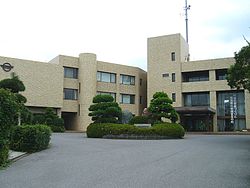Kyonan, Chiba
|
Kyonan 鋸南町 |
|||
|---|---|---|---|
| Town | |||

Kyonan Town Office
|
|||
|
|||
 Location of Kyonan in Chiba Prefecture |
|||
| Coordinates: 35°07′N 139°50′E / 35.117°N 139.833°ECoordinates: 35°07′N 139°50′E / 35.117°N 139.833°E | |||
| Country | Japan | ||
| Region | Kantō | ||
| Prefecture | Chiba Prefecture | ||
| District | Awa | ||
| Area | |||
| • Total | 45.16 km2 (17.44 sq mi) | ||
| Population (April 2012) | |||
| • Total | 8,691 | ||
| • Density | 192/km2 (500/sq mi) | ||
| Time zone | Japan Standard Time (UTC+9) | ||
| - Tree | Camellia | ||
| - Flower | Narcissus | ||
| Phone number | 0470-55-2111 | ||
| Address | 3458 Sakuma, Kyonan-machi, Awa-gun, Chiba-ken 299-2115 | ||
| Website | Town of Kyonan HP | ||
Kyonan (鋸南町 Kyonan-machi?) is a town located in Chiba Prefecture, Japan. As of April 2012, the town had an estimated population of 8,691 and a population density of 12 persons per km². The total area was 45.16 km².
Kyonan is located near the southern tip of the Bōsō Peninsula, facing Tokyo Bay. The area has a warm maritime climate with hot summers and mild winters.
The area of present-day Kyonan was part of ancient Awa Province. The modern town of Kyonan was formed by the merger of the towns of Katsuyama and Hota on March 30, 1959. With the creation of the city of Minamibōsō in 2006, Kyonan is the only remaining unincorporated portion of Awa District.
Kyonan serves as a commercial center for the surrounding region of southwest-central Chiba Prefecture. The primary industry is commercial fishing and agriculture (rice and flowers). Mount Saga has been used for narcissus cultivation at least from the Edo period 1603–1868, and Kyonan remains one of the largest producers of the flower in Japan. The tourist industry is a growing component of the local economy.
...
Wikipedia



